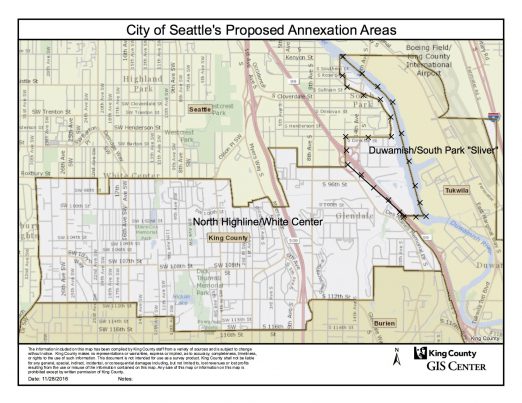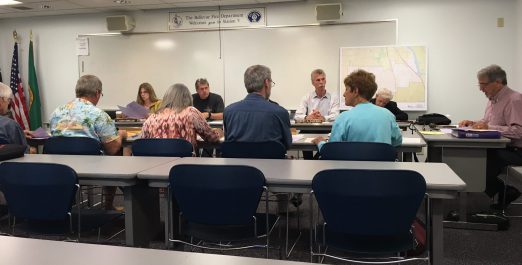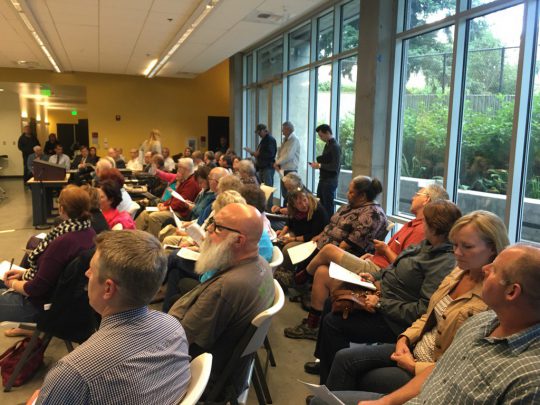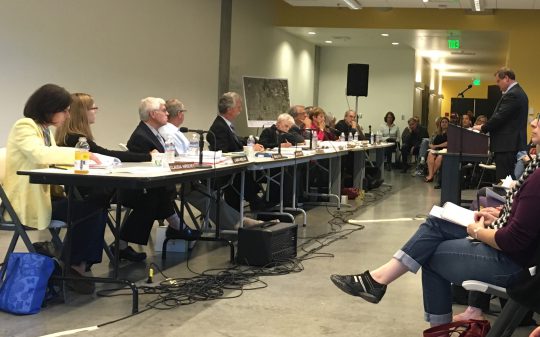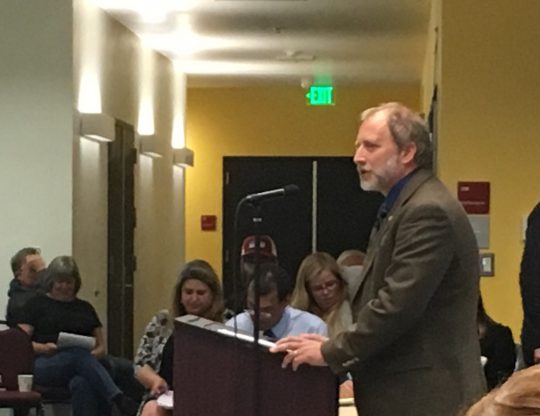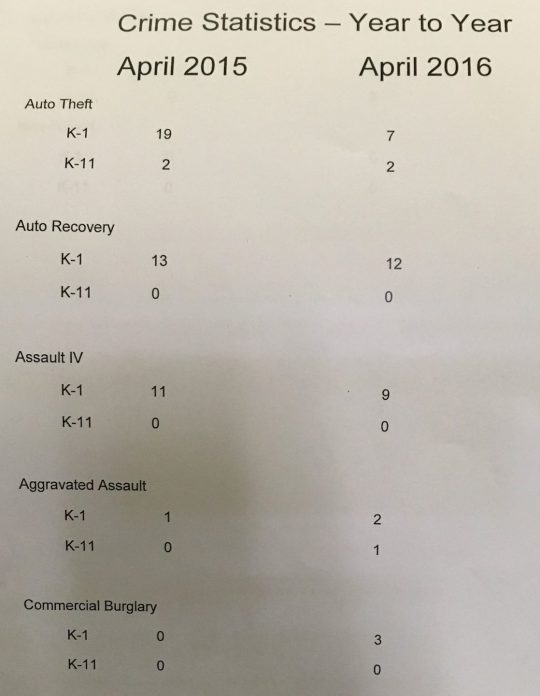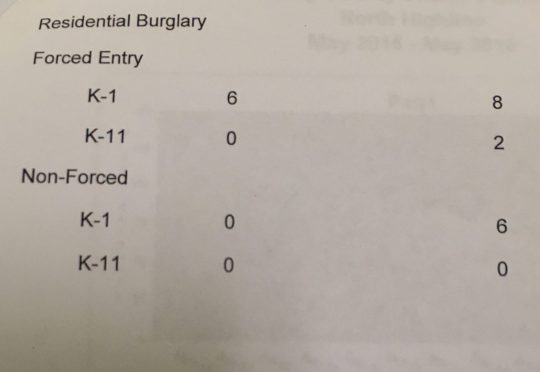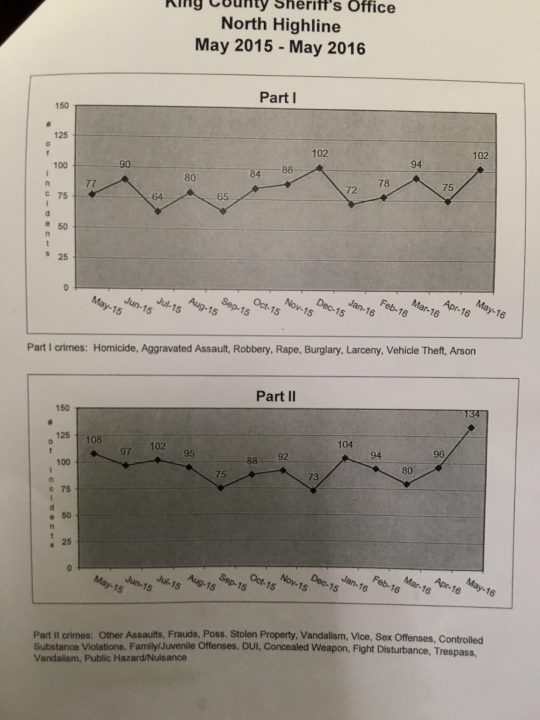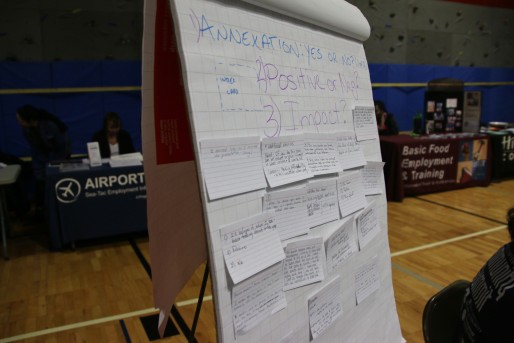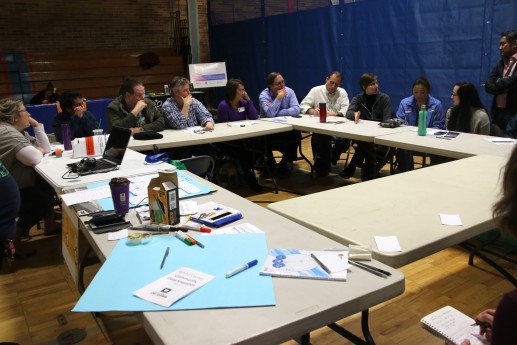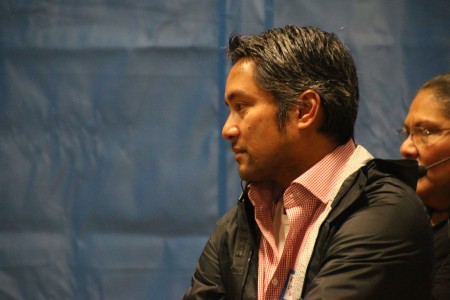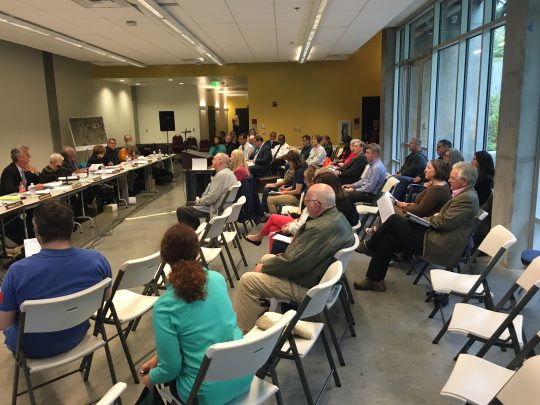
(WCN photo)
7:06 PM: We’re back at the Bethaday Community Learning Space in Dick Thurnau Memorial Park, at the start of the second night of the King County Boundary Review Board‘s hearing on Seattle’s proposal to annex most of what remains of unincorporated North Highline. Our coverage of Night 1, including video and as-it-happened reporting, is here. We’re doing it again tonight. This will start with public comment, and if that concludes before 9 pm or so, the board will publicly deliberate the annexation (following up to 10 minutes of rebuttal by the city of Seattle); if this runs long, one more night is set aside, this Thursday. Maybe about 30 people here tonight, about half of last night’s attendance.
(Added Wednesday morning: Unedited video of the hearing’s first half; second half is inline below, with our summarizing of that part of the meeting)
7:14 PM: The special assistant attorney general assigned to the board, Robert Kaufman, is continuing to explain the rules, including possible appeals after a decision. And now he’s again conducting an en-masse swearing-in for those who plan to speak tonight. Board executive Lenora Blauman says about 15 people are signed up to speak so far – individuals get up to 3 minutes, group representatives up to 10. Mike Mullen, who says he represents an area condo association, is first. He starts with a question, wondering about Seattle’s timetable for providing services to the community if annexation happens. “Will we have a representative with the city who will take charge of this program and offer it to us and let us know how to access the services available?” such as the Office of Economic Development and Seattle Police – he acknowledges that the Sheriff’s Office is short-handed, but wonders if SPD is staffed well enough to be an improvement. “I would like to know more details, more specifics; there seem to be a lot of smoke and mirrors going on.”
7:20 PM: Barbara Dobkin is the second to speak. While as she says, she’s long been involved with the community, including on the board of the North Highline Unincorporated Area Council, she makes it clear she is speaking as a resident. She takes note of last night’s mention that notices had gone out to residents before Burien’s version of this annexation hearing years ago; those notices were sent by the city of Burien, she points out, but Seattle sent out no such notices before this. She talks about the challenges the community faces; “how can Seattle and King County even begin to justify the annexation … when they have people living under I-5, camped out on sidewalks in Lake City and Ballard, and along Myers Way … the city is clearly facing a crisis and yet they want us to believe they can come and improve our lives.” She also says she wants to put on the record that NHUAC endorses a letter from Liz Giba (its president) opposing the annexation.
7:23 PM: Elizabeth Gordon is next. She is reading a letter she says is from Gary Wasdin of the King County Library System. It says residents would continue to pay off bonds for local libraries through 2024 but would not continue paying the library levy. The two KCLS branches have operating costs of about $1.5 million, she reads from the document. It outlines the possibilities for the two libraries that Wasdin had mentioned at the most recent meeting of NHUAC (of whose board Gordon is a member). An agreement would have to be negotiated. Next, she is reading comments from the White Center Chamber of Commerce, for which she serves as secretary. She says it would like to see the library be operated by King County, and that the Chamber supports the “concerns raised by Liz Giba. … Our big concern is whether we would be paying the same or more for less services,” and the Chamber also is concerned about changing to Seattle laws including the minimum wage. They’re also concerned about trust and follow-through. They would like to see Seattle put forth some efforts toward this area as a good-faith measure, but haven’t yet. She mentions some traffic changes the city made in the Delridge Triangle area just to the north of White Center but did not inform and engage others in the area. “It would be one thing if as part of this proposal someone from the county and the city would sit down and listen (but) with all due respect to (city and county reps Kenny Pittman and Karen Freeman) we don’t see them often enough” to establish a relationship or discuss needs. She raises one more issue: Licensing of marijuana businesses in the area. She discloses that she is administrator of White Center’s first recreational-marijuana store, but notes that West Seattle’s first-such store, right across Roxbury from White Center, is engaging in “marketing strategies” that seem detrimental to the community.
She moves on to mentioning the Myers Way encampment, which “is on the Seattle site, but the petty crimes that take place are on the North Highline side, and as far as we know right now, there is no coordination between the law enforcement (agencies) there, and it’s difficult because of the policy directives that Seattle Police have received.” She wraps up by mentioning the local poverty rate and says assurances are needed that policies and programs will keep that rate from going higher. And she says the community wants to be engaged, wants to know, “wants to be asked to be at the table.”
Board member Mary Lynne Evans asks a question about a sewer district that Gordon had mentioned along the way had concerns; that was the Southwest Suburban Sewer District, it’s clarified. “Did the White Center Chamber ever take a vote on annexation?” was the next question. Gordon’s reply: “Our members have mixed views …” but would either oppose it or request a delay until questions can be answered.
7:36 PM: Angelina Benedetti is the next person called; she says she was to read Wasdin’s statement on behalf of KCLS, but since Gordon done that, she’ll step aside. Board member Ronald Little asks for more on the statement that residents would continue to pay off the bonds and Benedetti says that goes back to the 2004 vote for that program, which is what generated the money to build the newly opened White Center Library. Next question is about the reciprocal agreement between Seattle and King County’s library systems, and that is affirmed.
Amanda Kay Helmick is called next. She is a West Seattle resident. She clarifies that she is speaking as a private resident, though she is involved with a community group in WS. “White Center is not a separate place for people in West Seattle, or Seattle. It’s connected. Roxbury has no boundary – it’s just a street.” She brings up the Westwood-Highland Park Urban Village plan in Seattle. The area is “just on the other side of (the city-county line),” she says, adding that while the city has not invested in the area, the process has been “reignited,” and the annexation of White Center is “a catalyst,” and that they want to join together in planning the future. “I really hope this board encourages that for Seattle and for King County to move forward. We are not separate, we are together … I want that to be the theme moving forward … it’s not us and them.”
Board member Ronald Little asks how the district-elected City Council is working for the area. (Helmick, though she doesn’t mention it, was a candidate for City Council.) She offers the caveat that she has more contact with government reps than most because of her advocacy, but so far, she has seen responsiveness from Councilmember Lisa Herbold and her staff.
Board member Stephen Toy asks Helmick for more information about the boundaries of the “urban village” that she mentioned. (We’ll add a link later to the documentation that shows that.) Helmick points out that the boundary goes right up to the city-county line.
Board member Paul MacCready asks if there is inclusiveness in the area from both sides of the line; Helmick says that in her efforts, she has worked to be inclusive. “Again, I think we’re all in this together, so from a community standpoint, I can say yes, but from an (organizational) standpoint,” she can’t say.
7:45 PM: Loretta Brittinham is at the microphone. If the area is annexed, she asks, what happens once the Legislature-approved diverted sales tax revenue runs out? She also wonders about the number of police that would be assigned to the area. “We don’t have a lot of property tax in the area,” she mentions, pointing out low-income housing that doesn’t generate that revenue. “A lot of people don’t go downtown (to Seattle) to shop any more because they don’t feel safe,” she adds, and then brings up some Seattle City Council decisions such as the bike-share buyout, and voices a lack of confidence in decisions the City Council has made. She also brings up schools, RVs, Hamm Creek pollution from encampments, and says she would like to see the utility districts remain independent.
7:49 PM: Bob Price says, “My main concern is safety.” He says he worked for years as a crossing guard, but never got support from the police department for a “race track” situation in the area because they were “shorthanded.” He brings up a “large crime problem in the Delridge area and South Park area” and says people have been “turned in” but nothing was done about it. He then brings up the South Park resident who was shot at the Boulevard Park 7-11 after attacking people with a hatchet. Next, he voices concern about zoning densifying and leading to overcrowded schools. His request is for annexation to be delayed “until something is done” about the issues he raised.
7:52 PM: Liz Giba speaks next. “I’ve lived in White Center since 1974.” While she is a North Highline Fire District commissioner, she is not speaking for that board, she says: “I am speaking as a concerned citizen. … As you review Seattle’s notice of intention, I think you have found, there is no plan … Seattle told you they would have a new comp plan by the end of last year. No comp plan yet, no housing plan yet, still hasn’t been heard by the City Council, so they don’t really know what they want to do with us. What they have told you is outdated information. They’re telling us that the soonest they will annex is 2019, but all the numbers in the notice are for 2014 or prior – that makes it at least 5 years out of date. It’s not accurate.” She brings up the new library, and says the city did not reach out to KCLS, or else “could have had this all wrapped up.” She mentions Kenny Pittman’s White Center visit in March, and says he said “don’t worry about zoning,” but that Seattle annexation would densify this area greatly. She wonders what being part of an “urban village” would mean for poverty. “I feel like our best interests are not being considered here. … I feel it’s a violation of ethics and morals and the Fair Housing Act.” Giba also mentions that she followed up with Jenn Ramirez Robson about comments made last night on behalf of the King County Housing Authority, and feels that low-income housing and poverty in this area were underestimated. “King County should be ashamed for its failure to this community, and I don’t feel Seattle is ready.”
7:58 PM: Tiffany Mowatt is next, saying she is a 20-year resident, and is here “in support of Seattle’s annexation of White Center, because there are many programs (the city could bring) that could help the community here.” That would include more services for families with young children, and she lists several, including health and education programs. “For school-age kids, we could potentially have more after-school services and parks program … currently county services are extremely limited, and as a result, supports for academic, social, and emotional needs … go unmet.” Local businesses cannot be competitive without more support, she adds, including “small refugee/immigrant businesses.” She mentions White Center Community Development Association executive director Sili Savusa, who was present last night but couldn’t be here tonight. She says, “We deserve annexation to Seattle.” On a followup question, she clarifies that she is associated with WCCDA.
8:01 PM: Meryl speaks next, saying she was initially in favor of annexation but “what I’ve seen on Myers Way makes me change that view because I haven’t seen any good-faith effort by the city of Seattle to” fix the problems there, including, she lists, open drug use, prostitution, garbage, and “protection by the Seattle Police Department of these folks, a lot of whom are not good folks,” while citizens who “try to clean it up … are getting harassed.” She says a neighbor of hers had to put in an electric fence because animals and garden vegetables were being stolen and people were relieving themselves in yards. If the community is to consider annexation, the city should first clean up that area and “build some trust,” she says. She then mentions the city’s rules for landlords, which she says require a fee and make eviction difficult.
Board member Evans asks for clarification of Meryl’s statement that the city “placed” the RVs there. She mentions a Community Police Team officer responsible for that.
8:05 PM: Next person is Paul McLaughlin, who says he feels he should have been notified by mail but was not. He found out about the meeting from a neighbor. “I’m a disabled vet, I don’t use a computer. I don’t feel I’ve been represented properly or been notified. I like our community. I feel we should stay the way we are. We’re a very poor area. If Seattle takes over this area, it’s going to chase away the seniors.” He says he owns five rental properties that are affordable housing but feels annexation would change that. “If you’re going to get rid of our affordable housing, then we have problems.” He thinks notices sent by mail “would (have) fill(ed) this room.” He concludes, “Please pay attention to the local people.”
8:07 PM: Mark Ufkes is next. He says he speaks for the White Center Homeowners’ Association, which feels that if the area has to be annexed, Seattle is better than Burien. He speaks of his son Hank, who went to the Evergreen campus for high school and enjoyed being part of an ethnically diverse student body. He talks about his wife Lois Schipper (who testified last night) being involved for years in schools. Another of his sons, Patrick, volunteered at the White Center Food Bank. And he says his family owns “a couple of rentals.” He then brings up Dick Thurnau, namesake of the park where the hearing is happening. He and Thurnau advocated for the park for years, he said, and also mentioned having spent years on the Unincorporated Area Council, but said he had issues with the group’s claim to be elected representatives of the community “because only 20 or 30 people voted.” He goes on to mention his time leading the White Center Chamber and working to diversify its board, and then collaborating with the WCCDA, also creating a website that he says he doesn’t know if the Chamber manages any more. The Chamber also placed welcome signs around the area. “We took this all on ourselves because King County doesn’t have the resources to (tackle) these problems.” He goes on to mention other initiatives including ones dealing with alcoholism and homelessness, and says that people complaining about various problems on the Seattle side of the line shouldn’t infer those problems don’t exist in the unincorporated area because they do.
Next, he mentions the library, and an effort by the Boy Scouts to remove trash from encampments on the site where the library eventually was built, then pointing out the site to KCLS. “But some people in this room fought aggressively” against that. He alleges that the people who “complained tonight the most about Seattle” are those who most supported annexation by Burien (rejected by voters in 2012) and elaborates on that point. Then, to another issue brought up last night, he brings up the fire department, and its rating of local districts as well as Seattle. “Here’s what they told me on the phone – that NHFD’s classification is a 4 – Seattle’s classification is a 2, the highest you can get” – he says he’ll submit documents supporting/explaining that. “Seattle has one of the best fire departments in the state,” he declares. He says it increased its commitment to excellence in the wake of the Pang warehouse arson 20+ years ago. “What I want to say is that Seattle will always have more resources” in terms of public safety, he adds. And he says that before the move of Medic 4 to Burien, the unit responded here from SeaTac, almost 15 minutes. “The fire districts have done a good job for us, but some of their issues are about Burien, not about Seattle, and they’re always going to complain about Seattle, and it’s not fair.”
8:18 PM: Carol, a Myers Way resident, says she’s representing the Top Hat Action Team, which is “dealing with the homeless crisis and the RV encampments,” and has turned in exhibits to show what she’s talking about. She asks for a postponement until “we know what we’re signing up for … it’s not what we want.” She says other speakers have covered many points about which she too is concerned, including the library, but wants to see changes and “new data” before any vote would happen.
8:23 PM: Pat Murakami, president of the South Seattle Crime Prevention Council, says she is speaking as a private citizen and wants to say that Seattle has “a long history of broken promises” in relation to annexation. In Columbia City, for example, there are no sidewalks; in North Seattle, too. “I’m very concerned about Seattle’s promise to you, to the White Center community, of (a certain number of) police officers” – the South Precinct, she says, is dramatically understaffed. Even the added police that Seattle’s mayor is pursuing will not be enough, and “we can’t afford to dilute our resources.” She says promises were made about economic development along the light rail line on Martin Luther King Junior Way but nothing has happened and businesses have been lost. “If Seattle can’t develop an area like that … what are they going to do for this community?”
Public testimony is now closed, and Seattle has the opportunity for rebuttal. A break will be taken first.
(Added Wednesday morning: Second half of our unedited video of the entire meeting)
8:34 PM: After the break, Karen Freeman of the King County Executive’s Office is asked to come up and answer some questions that were asked last night. Among other things, the questions were about services that Seattle provides but King County does not; she says there are many. She also says there is a joint planning effort on the drawing board related to this. The intention is for that to be done in 2017, she says, while noting that “we have one full-time employee who does this type of work for all of King County, while the city has 40 staff members (approximately) who (do that work).” She again mentions the county’s projected “$50 million shortfall.” Board members are asking about the negotiations over a possible fire-station site in Puget Sound Park years ago; it was located, she said, in the northern part of the previous Burien annexation of part of North Highline. “The leadership at the time in the city of Burien was not excited about the proposal and objected, so the fire district dropped out of the negotiations.”
Now, Seattle’s special counsel James Haney, who was the first to speak last night, gets the chance for up to 10 minutes of rebuttal. He says he is accompanied by Pittman and by Seattle Fire Chief Harold Scoggins as well as assistant chief Jay Hagen (Pittman and Hagen also were here last night).
Haney answers a few questions including confirming that sales-tax money diverted to Seattle specifically to compensate for the costs of annexation are required to be spent only in the annexation area.
He asks Chief Scoggins to address a few points, including saying that it is up to a community to set the levels of fire service. “I came here tonight for a couple reasons – I want you to know that if this annexation does take place, we want the annexed area to receive all the same service other areas (of the city) receive.” He mentions last night’s questions about Advanced Life Support services, and notes that Seattle is a national center of innovation “in that level of care.” So, “what does it look like tomorrow if the annexation does take place – our goal is to try to get ALS services on scene within 8 minutes.” He said the city didn’t get to 90 percentile of that in 2015, but almost – 89 times out of 100, up from 87 the year before. “We would look at the system as a whole and place our resources the places they need to be” to achieve that goal. He also says that Basic Life Support units already carry defibrillators and other high levels of service. He then mentions the concerns about North Burien and possible “automatic aid” – that is supposed to include reciprocal aid. He notes that the North Highline station “runs a lot of calls” in North Burien, so that might require a “contractual discussion” if services were not being received in exchange. He said it would be important to be “open and transparent” about what Seattle could provide, compared to what the area is getting now.
Board member Little asks if Seattle has any other arrangements with “an equal sharing of assets.” Chief Scoggins says yes, but none are formal, though they want to achieve that. One is to the north of the city, one to the east. “One of the benefits if this annexation takes place -the number of resources for a structure fire or vehicle accident, we have 33 stations” – as an example, he mentions a fire in North Seattle yesterday that led to two alarms, and discusses how resources were moved around the city while so many were at that fire.
Board member Kisielius asks about the ALS issue. “That’s one of the things we would need to spend a little more time digging into the resources.” He says an ALS unit costs $1.5 million, an engine and four people more than $2 million. “What you heard about that response time is based on our medic unit being at Station 32, where it is today … but if we are adding almost 18,000 new residents to the community, with … 1,800 responses annually … we have to look at all those things and pencil out what we are looking at, and I can come back to you with that once I have a clearer understanding of that.”
Another board member says, “It sounds to me like that includes capital improvements (required), not just operational changes, which is what we were led to believe in the presentation.” Chief Scoggins says not necessarily, but if the conversation is that Seattle will provide coverage for North Burien, they need to dig into some documents “and engage in that agreement” and possibly make some modifications to it.
8:58 PM: Now Haney resumes the rebuttal. He says he provided a couple of exhibits with more information responding to the questions about level of fire service and standards, as well as 2015 statistics. “As the chief said, the city is currently meeting those standards, making the 8-minute response time in ALS 89 percent of the time (and aiming for) 90 percent.” Regarding the 2009 land-for-a-fire-station issue, “King County does not just have land lying around … in 2009 it made a good-faith effort … (and that) was rejected.”
Summarizing, he says Seattle is the only jurisdiction that could annex this area, but if the currently available tax revenue goes away, “Seattle would have to go away.” Again, he says, they’re asking the board to give residents the chance to vote. He acknowledges people’s concerns, and says “those are certainly things people can vote their minds on,” while asking the board “to give them that chance.” He adds that there were “similar issues (with fire services) in the Burien annexation” but “did not allow those issues to prevent the annexation” instead acknowledging that Burien and the county would have to work together and establish interlocal agreements. “We certainly want to sit down with the fire districts and … resolve these issues … we would ask that you please allow this annexation to go forward for a public vote.”
Board member Jay Hamlin asks whether water/sewer district could remain unassumed “indefinitely.” Theoretically, yes, Haney replies. But “it’s generally the city’s policy to provide water and sewer services within its boundaries” eventually, though he doesn’t foresee that happening within at least six years, as had been said last night.
Board member Little asks about the city’s plan to engage this community if the board votes to proceed with the annexation process, given the lack of trust voiced, and lack of notice pointed out. He suggests Pittman answer that, “since that’s his job.” Pittman takes the microphone: “One of the things we’re planning to do if the board moves forward … we’ve already had conversations with our Department of Neighborhoods … we will have an extensive engagement process, using multiple languages … an 8-to-10-month process, to sit down to meet with every resident, every resident group, an extensive outreach using the languages of the community and also engaging with leaders of the community to have those meetings.”
Haney elaborated on that mentioning Department of Neighborhoods director Kathy Nyland’s statement committing a “liaison” to the area. Also, regarding the Comprehensive Plan – Seattle 2035 – “is currently making its way through the process,” lengthened because its environmental-impact statement “has been appealed.” It “does provide for an engagement process that gets people involved and talks about the types of things that happen in urban villages,” as well as discussing zoning. “There’s going to be lots of public engagement.”
Board member James Polhaus wonders how this area would be represented in the City Council District system. “It would be in District 1, the West Seattle area,” says Pittman, adding that there’s a plan to review the district boundaries and population again in 2020-2022, so District 1 would be a little larger for a while. In response to another question, he also promises that the city would be talking with KCLS about the options it suggests be considered for operating the White Center and Greenbridge libraries. Haney says the city already has had “amicable” discussions with the county and “believes the issues can be resolved.”
Board member MacCready brings up the Myers Way homeless encampments and asks about Seattle’s policy. Uneasy laughter ripples around the room. Haney says he can’t fully address that, though he is well aware of Myers Way as he drives past it daily, as a West Seattle resident. Board member Toy wonders when the “lion’s share” of discussions related to the various issues, would it be before going to a vote, or afterward? Haney says he would think before rather than after, “because it would make the vote, obviously, more informed.” He mentions again a June 29th meeting coming up to talk with North Highline Fire District.
Pittman picks up the issue, saying it’s Seattle’s policy to “have it all worked out” regarding such issues before moving forward with a vote, likely even before the City Council would provide with putting this to voters. He says again that if there’s a November 2017 vote, annexation would take effect in 2019; if November 2018, it would be 2020. “The reason for the 13-month gap is that because this area is so large, we would want to go through a formal budgeting process” first.
Board member Kisielius comes back again to fire-service issues: “Does the city or will the city have the resources to assure that the 8-minute level of ALS will be met if this area is annexed?” Chief Scoggins returns to the microphone. “If we don’t have the resources, I will let you know we don’t have the resources. If we do, I will also let you know that. …” He reiterates that he needs to find out what this area’s level of service is today, but 8-minute is the citywide standard. So, follows up Kisielius, how does that relate to the decision we need to make? Haney: “Seattle has a world-class ALS system currently, and Seattle is not going to annex this area if it cannot provide that service and provide those resources. So I think you have to look at it as … once the board makes this decision, there’s the decision the City Council has to make to place it on the ballot … then, once the election takes place,the City Council would have to (affirm the annexation and go forward). The city wouldn’t be presenting the annexation to you if it didn’t feel there was a way to provide those resources … the city is … Chief Scoggins would tell you, the city is not going to want to jeopardize the service to its existing residents by diluting its current service.”
Kisielius says that’s a good reminder that there are additional steps even before the annexation would go to a vote of the people. So, she asks Chief Scoggins, you would not recommend that the annexation go to a vote if you didn’t feel you could provide that service? He says the city has 7 medic units, and a medical services officer. “Today if your medic unit left this area, I’m not sure where another medic unit is and where it would come from … but (if this was in the city today) we would be moving our resources around” and there would be backup available. “We also have five aid cars behind it – they’re not medics, but our aid cars run EMS calls all day long – that’s another high level of care we have in the system.”
9:20 PM: The rebuttal and followup questions are over. The board will discuss what to do next. There are three options: Continue the hearing for more oral/written testimony; close the hearing to oral testimony but leave it open to written testimony with a deadline for submittal; close the hearing and begin to deliberate “review of the factors and objectives to reach a decision, and we can make a decision on the time frame.” A motion is made and seconded for option three. Blauman says “once the hearing is closed, you don’t have to deliberate tonight, but you have to come to a decision … within 40 days of closing the hearing.” She also points out this room is set aside for Thursday, and deliberations could take place then, but don’t have to. Board member Kisielius says she’s in favor of deliberating at least 20 minutes until the booking of the room for tonight is over (9:45). Unanimous vote to close the hearing to oral and written testimony – and before deliberating, board member Evans says she has concerns. She says that if the annexation does not take place, the sales-tax money passed by the legislature this year is lost. But she “has about four issues” of concern – the fire-services issue for one, and the lack of a “definitive statement on what it would take” to reach desired service levels. She says she also feels there are “holes” in the library, sewer, and water concerns that have been brought up. “I just don’t feel comfortable saying go ahead with this annexation” without more information. She also is concerned about the member of the public who was upset that he was not notified about the hearing. That’s not usually up to the board to do, she says, but she says it’s up to the community, to get their fellow community members involved in the discussions before it goes to a vote, and she feels the city is sincere in its promise to have an engagement process.
Next, board member MacCready says he feels the water and sewer issues are a moot point – before anything could change, they’d have to come back to the board, and they could discuss fees at that time. Board member Hamlin says he feels that the library issue is not a sticking point because it seems discussions are taking place and “that’s at least close to being wrapped up – felt like to me that was being addressed appropriately.”
Board member Claudia Hirschey says she feels there’s enough time to talk more about fire services, and she also says that there’s a sense of urgency about this annexation, and the city will have to have those answers before it talks to the community. “The benefits of greatly enhanced police service, the sales tax subsidy for this area with the sunset, greatly outweighs the risk that we feel about the undefined operating agreements” especially fire.
Board member Sylvia Bushnell says she also thinks there’s time for some of the issues to be worked out, specifically mentioning the library matters.
Board member Polhamus says he believes this comes down to two issues – “getting details of the fire service worked out” and “concerns about the zoning” – noting that Seattle says it’s looking at what’s “closest to the county zoning,” while acknowledging concerns about increased density vis-a-vis Seattle zoning. He agrees that the library agreement “is an easily solved issue.”
Board member Hamlin says it looks like the city has matching zoning for many types, except perhaps 18 units per acre vs. 26 units per acre. “It looked actually pretty equivalent, and the city did a nice job showing that equivalency.”
MacCready said he agreed with that assessment. “They always don’t match exactly … I do think the main issue with zoning is the increase in density in the single-family zones.”
Kisielius says she feels the city will “have its work cut out for them” in communicating service availability to this area, in outreach and beyond. She says it was clear to her that at least in the services-provision regard, annexation “would be very beneficial for this area.”
Hirschey moves to direct staff to prepare a resolution in favor of annexation. Multiple members speak up to second it. She says it is a “natural” annexation, follows existing boundaries “and leaves no unincorporated islands,” and that the area “itself is a logical service area .. that after annexation would be served by the city of Seattle. … We gloss over the street system because it’s not a natural utility but Seattle is in a much better position” to manage it. She continues listing the criteria that she feels support this.
9:44 PM: Discussion time for the motion. Hamlin suggests perhaps a letter could be drafted to express the board’s concerns to the city. Not conditions, he clarifies, but concerns. The hearing and resolution report would do that, Blauman points out. Polhamus clarifies that this would not be a final decision, just a direction for staff to prepare a motion. Blauman says yes, and that the official vote would be at its July meeting.
The motion passes 8-1, with Kisielius as the lone no vote. So this is not a final approval, but it’s a big step toward one. (We recorded this entire night on video as we did last night, and will add it, again in two pieces separated by the 8:25 pm break, as we get it processed in the hours ahead.)
The BRB’s July meeting is at 7 pm July 14th, Bellevue Fire Station #9, 12412 SE Newcastle Way.
9:04 AM WEDNESDAY: We’ve now added our video of the full meeting, again in two parts – first half at the top, second half at the point in the story where we note the five-minute break.
-Tracy Record, WCN editor

